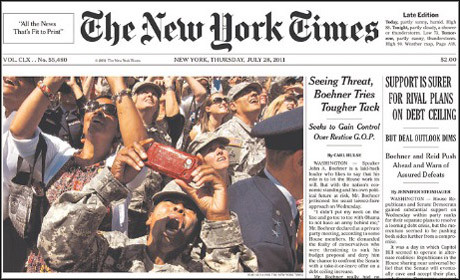
Today's New York Times front page, showing Silva's photograph
A war photographer who was severely injured by a landmine in Afghanistan has returned to the front page today (28 July) with a picture in the New York Times.
The image accompanies an inside-page story about the closure of the Walter Reed Medical Centre in Washington, where Portuguese-born Joao Silva has been recovering from his injuries for seven months.
Silva was working for the New York Times, embedded with the US military in Kandahar Province, when he stepped on the mine on 23 October last year, losing both his legs below the knee.
He continued to take photographs after the explosion, capturing his rescue by army medics in a series of dramatic images.
Silva then underwent emergency surgery at a military hospital in Kandahar Province, before being treated at Bagram Air Base near Kabul and then flown to Germany.
At the end of October, Silva was moved to the Walter Reed Center, where he underwent several operations and was visited by US vice president Joe Biden and first lady Michelle Obama.
A support fund was set up for Silva in November by his friend and fellow photographer Greg Marinovich, Marinovich's wife Leonie, and the charity Photoshelter. They launched a website to gather donations and chart the progress of Silva's recovery.
Then in February, Silva took his first steps on new prosthetic legs.
Silva can now walk but needs the assistance of a cane, which he has to transfer between hands before taking a picture.
Speaking to the New York Times, he conceded that it was frustrating not being as nimble as he used to but said that he was happy with his first day's work.
"It was a matter of making the best of what I had. There will come a time when I can run, but now I can walk."
Silva, who has been based in Johannesberg for the majority of his career, has covered conflicts in the Middle East, Russia, Africa, Eastern Europe, Iraq and elsewhere. He and Marinovich are co-authors of The Bang-Bang Club, a book about the work of photojournalists covering ethnic violence in South Africa in the early 1990s.
He is a winner of the the South African Press Photographer of the Year Award, in 1992, second prize in the World Press Photo awards, 2005, and an honourable mention in the World Press Photo Awards, 2006.
Free daily newsletter
If you like our news and feature articles, you can sign up to receive our free daily (Mon-Fri) email newsletter (mobile friendly).
Related articles
- Axel Springer CEO on OpenAI deal: 'We must protect intellectual property of news content'
- Audiences, AI and audio apps: five talking points from Perugia
- From Reuters to The New York Times, Big Oil pays 'most trusted media brands' to push greenwashing
- Seven sources of free images for journalists
- Reuters publishes book to honour life of late photojournalist Danish Siddiqui











